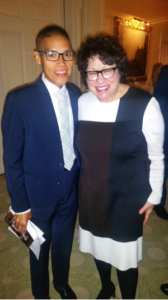Linking It Together: Youth Opportunities and Participation
 •
•
A president. A judge.
An African American president. A Latina judge.
An African American President of the United States. A Latina United States Supreme Court Justice.
In April, I felt the honor and pride of seeing Associate Justice of the Supreme Court of the United States Sonia Sotomayor, and listening to former United States President Barack Obama via online streaming. There are many dichotomies between these two made-in-America minority leaders, but there are also many similarities that my mind, that of a first generation American and first generation college graduate, combined.
In a world that faces us with many challenges, both Justice Sotomayor and President Obama share the belief that change happens at a community level, and that progress is a result of being a part of a community.
Whether it’s building community at a national level by voting, or be it at a local level by volunteering at your neighborhood community-based organization, engaging with others is pivotal for progress – not only for yourself, but for your community. Democracy thrives when there is participation; when its citizenry is engaged and active, and further, I believe that participation allows individuals to feel invested. At the very least, engagement may bring about conversation between individuals, perhaps facilitating understandings.
But these understandings, these conversations and this engagement are null if opportunities are not provided. And more efforts to provide these possibilities of engagement are necessary, especially for youth.
While adults may be more proactive in looking for opportunities, youth are still formulating themselves and don’t always know what’s available to them. I can attest to this as a Mexican-American born and raised in an underserved community of the Southwest side of Chicago. I personally witnessed the unfair and negative treatment toward my at-the-time undocumented parents and other family members. I experienced being laughed at because I didn’t always wear the nicest clothes to school. I saw how working at a hot factory for less than the minimum wage was seen as “third world.” Because of these disadvantages, and as a way to “pay-it forward” to organizations that personally helped me advance, I began to volunteer with goals of helping others. It is an ideal that was seeded within me at a young age, one that over time, has developed.
During her conversation hosted by the Aspen Institute’s Latinos and Society Program, Sotomayor said, “There’s a continuing tension in America between the image of the person who pulls themselves up by the bootstraps, and the person who believes that you need a lift to get up sometimes. . . For those of us who understand that sometimes no matter how tall the heel on your boot is, the barrier is so high that you need a small lift to help you get over it – they will understand that the inequalities in society build that barrier so high. Unless you do something to knock it down or help that person up, they will never have a chance.” I believe this could be correlated to youth seeking guidance. Sometimes, opportunities are necessary for that guidance to flourish.
Similarly, at his first public appearance since wrapping up his second presidential term, during his discussion with youth leaders hosted by the University of Chicago, Obama asked, “So the question then becomes: what are the ways in which we can create pathways for [youth] to take leadership, for them to get involved?”
Opportunity is an ideal deeply embedded in the American values of equity, fairness and mobility; opportunity means that everyone has a fair chance to achieve his or her full potential, and thus, we must strive to create opportunities for youth. Because, if we take President Obama’s advice into context, “Worry less about what you want to be, and worry more about what you want to do,” opportunities for engagement are critical.
As individuals, our personal ideas and notions will continue to evolve, and over time, some concepts may change, however, I believe that as we grow, as we become adults, we develop ideals that we cement within ourselves. At my core is volunteering and helping others; helping the underserved, those in underserved communities, and the marginalized who aren’t served fairness and justice.
If a Latina with a tough upbringing can sit on the bench for the highest court in the world’s most powerful nation, and if an African American boy can become president of the most powerful nation, we must continue to foster more opportunities for youth to engage, for youth to civically participate.









